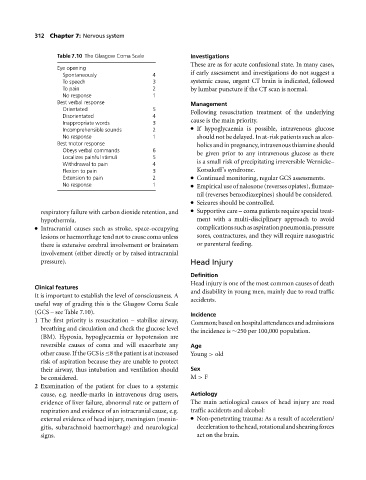Page 316 - Medicine and Surgery
P. 316
P1: FAW
BLUK007-07 BLUK007-Kendall May 25, 2005 18:18 Char Count= 0
312 Chapter 7: Nervous system
Table 7.10 The Glasgow Coma Scale Investigations
These are as for acute confusional state. In many cases,
Eye opening
Spontaneously 4 if early assessment and investigations do not suggest a
To speech 3 systemic cause, urgent CT brain is indicated, followed
To pain 2 by lumbar puncture if the CT scan is normal.
No response 1
Best verbal response Management
Orientated 5 Following resuscitation treatment of the underlying
Disorientated 4
Inappropriate words 3 cause is the main priority.
Incomprehensible sounds 2 If hypoglycaemia is possible, intravenous glucose
No response 1 should not be delayed. In at-risk patients such as alco-
Best motor response holics and in pregnancy, intravenous thiamine should
Obeys verbal commands 6 be given prior to any intravenous glucose as there
Localizes painful stimuli 5
Withdrawal to pain 4 is a small risk of precipitating irreversible Wernicke–
Flexion to pain 3 Korsakoff’s syndrome.
Extension to pain 2 Continued monitoring, regular GCS assessments.
No response 1 Empirical use of naloxone (reverses opiates), flumaze-
nil (reverses benzodiazepines) should be considered.
Seizures should be controlled.
respiratory failure with carbon dioxide retention, and Supportive care – coma patients require special treat-
hypothermia. ment with a multi-disciplinary approach to avoid
Intracranial causes such as stroke, space-occupying
complicationssuchasaspirationpneumonia,pressure
lesions or haemorrhage tend not to cause coma unless sores, contractures, and they will require nasogastric
there is extensive cerebral involvement or brainstem or parenteral feeding.
involvement (either directly or by raised intracranial
pressure). Head Injury
Definition
Head injury is one of the most common causes of death
Clinical features
and disability in young men, mainly due to road traffic
It is important to establish the level of consciousness. A
accidents.
useful way of grading this is the Glasgow Coma Scale
(GCS – see Table 7.10).
Incidence
1 The first priority is resuscitation – stabilise airway,
Common;basedonhospitalattendancesandadmissions
breathing and circulation and check the glucose level
the incidence is ∼250 per 100,000 population.
(BM). Hypoxia, hypoglycaemia or hypotension are
reversible causes of coma and will exacerbate any Age
other cause. If the GCS is ≤8 the patient is at increased Young > old
risk of aspiration because they are unable to protect
their airway, thus intubation and ventilation should Sex
be considered. M > F
2 Examination of the patient for clues to a systemic
cause, e.g. needle-marks in intravenous drug users, Aetiology
evidence of liver failure, abnormal rate or pattern of The main aetiological causes of head injury are road
respiration and evidence of an intracranial cause, e.g. traffic accidents and alcohol:
external evidence of head injury, meningism (menin- Non-penetrating trauma: As a result of acceleration/
gitis, subarachnoid haemorrhage) and neurological decelerationtothehead,rotationalandshearingforces
signs. act on the brain.

